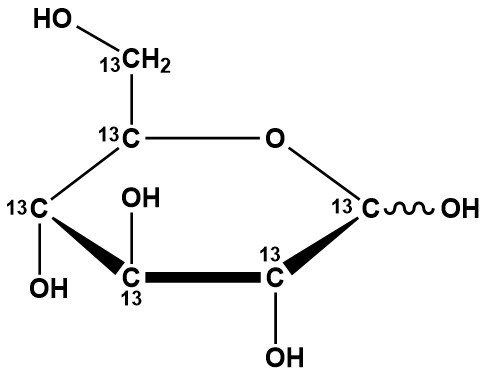| Labeled CAS #: | 110187-42-3 |
| Unlabeled CAS #: | 50-99-7 |
| Molecular Formula: | (13C)6H12O6 |
| Molecular Weight: | 186.1 |
| D-Glucose-13C6, also known as Glucose-13C6, D-(+)-Glucose-13C6, or Dextrose-13C6, is a stable isotope-labeled form of D-glucose where all six carbon atoms are replaced with the carbon-13 (13C) isotope. With a molecular formula of 13C6H12O6 and a molecular weight of 186.11 g/mol, this compound is a critical tool in metabolic research, biochemical analysis, and related fields. Its CAS number is 110187-42-3, and it serves as a non-radioactive tracer for studying glucose metabolism, offering high sensitivity due to the near-zero natural abundance of 13C in glucose. 1. Chemical and Physical Properties • Molecular Structure: D-Glucose-13C6 retains the same chemical structure as D-glucose, a monosaccharide with a six-carbon backbone, but all carbon atoms are 13C-labeled. Its SMILES notation is O[13CH2][13C@H]1O13C@H13C@H13C@@H[13C@@H]1O, reflecting its stereochemistry and isotopic labeling. • Physical Form: It appears as a white to off-white powder with a melting point of 150–152°C. • Solubility: Highly soluble in water (100 mg/mL, requiring ultrasonic assistance), but insoluble in ether and alcohol. • Isotopic Purity: Typically ≥99 atom % 13C, ensuring minimal interference from natural carbon isotopes in analytical studies. • Optical Activity: Exhibits a specific rotation of [α]25/D +52.0°, c = 2 in H2O (with trace NH4OH). • Stability: Stable at 4°C when protected from light and stored under nitrogen. In solution, it should be stored at -80°C for up to 6 months or -20°C for 1 month to prevent degradation. 2. Applications D-Glucose-13C6 is a versatile compound with applications across multiple disciplines, primarily as a metabolic tracer, synthesis ingredient, minimal media reagent, and internal standard. Below are its key uses: 2.1 Metabolic Tracer Studies D-Glucose-13C6 is widely used to trace glucose metabolism in vivo and in vitro, leveraging nuclear magnetic resonance (NMR) spectroscopy and mass spectrometry (MS) to track 13C incorporation into metabolic pathways. Its key applications include: • Glycolysis and TCA Cycle Analysis: By observing 13C distribution in metabolites, researchers can study glycolysis, the tricarboxylic acid (TCA) cycle, and the pentose phosphate pathway. For example, it has been used to monitor 13C incorporation into amino acids and other metabolites in cell culture filtrates and protein hydrolysates. • Metabolic Flux Analysis (MFA): Its low natural abundance (<1%) facilitates precise isotopomer analysis, making it a cost-effective tracer for studying glucose-related catabolism. • In Vivo Kinetics: A liquid chromatography-mass spectrometry (LC-MS) method using D-Glucose-13C6 as a tracer has been developed to assess glucose kinetics in vivo, providing insights into glucose turnover rates. • Insect Metabolism: In studies with Ceratitis capitata (Mediterranean fruit fly), D-Glucose-13C6 was incorporated into larval and adult diets to track amino acid metabolism, revealing impacts on hatching rates, larval development, and mating behavior. 2.2 Synthesis Ingredient D-Glucose-13C6 serves as a starting material for synthesizing labeled compounds. For instance, it has been used to synthesize methyl 4′-O-methyl-beta-D-cellobioside-13C12 and uridine diphospho (13C6)glucose, critical for NMR studies and biochemical synthesis. 2.3 Minimal Media Reagent In recombinant protein production, D-Glucose-13C6 is used in minimal media to support cell growth while enabling isotopic labeling of proteins for structural studies via NMR or MS. 2.4 Internal Standard Its high isotopic purity makes D-Glucose-13C6 an ideal internal standard for quantifying D-(+)-glucose in analytical assays, ensuring accurate calibration in HPLC and MS methods. 2.5 Cell Culture Studies D-Glucose-13C6 is added to cell cultures to monitor fluctuations in metabolite levels, such as amino acids, providing insights into cellular metabolism under various physiological conditions. 3. Efficacy The efficacy of D-Glucose-13C6 stems from its high isotopic purity and the low natural abundance of 13C, which minimizes background noise in isotopic tracing. Key evidence includes: • Insect Studies: In Ceratitis capitata, diets supplemented with 0.1 g D-Glucose-13C6 in 25 g of carrot medium (for eggs) or 1 g in 15 mL water (with sucrose for adults) showed measurable 13C incorporation. However, it slightly reduced egg hatching rates (from 85% to 79%), larval development (emerged adults from 57% to 50.6%), and mating frequency, indicating potential metabolic stress at these doses. • Metabolic Tracing: Studies demonstrate its effectiveness in tracking glucose-derived metabolites through glycolysis and the TCA cycle, with mass isotopomer distributions (MIDs) corrected for natural isotope abundances providing clear metabolic profiles. • Analytical Precision: Validation studies show strong correlation between the area under the curve (AUC) in LC-MS and the dry weight of D-Glucose-13C6, confirming its reliability as a calibration standard. 4. Limitations Despite its utility, D-Glucose-13C6 has some limitations: • Biological Impact: In Ceratitis capitata, its use slightly impaired biological processes like egg hatching and mating, suggesting potential toxicity or metabolic interference at higher doses. • Stability in Solution: Solutions are unstable and require immediate use or aliquoting with storage at -80°C, complicating experimental workflows. • Limited Specificity in Complex Systems: In complex biological systems, distinguishing 13C-labeled metabolites from background signals can be challenging, requiring advanced analytical techniques like LC-MS or NMR. 5. Practical Considerations • Storage and Handling: Store as a powder at 4°C under nitrogen, protected from light. Solutions should be prepared fresh, filtered, and sterilized with a 0.22 μm filter if used in cell culture or in vivo studies. • Dosage: For in vivo studies, dosages like 0.1 g per 25 g of medium or 1 g per 15 mL of water are effective but should be optimized to minimize biological impacts. • Analytical Techniques: Use with NMR or LC-MS for optimal detection of 13C incorporation. Ensure proper calibration with standards to account for natural isotope abundances. D-Glucose-13C6 is a powerful tool for metabolic research, offering high sensitivity and versatility as a tracer, synthesis ingredient, and internal standard. Its ability to track glucose metabolism through pathways like glycolysis, the TCA cycle, and the pentose phosphate pathway has made it indispensable in studies ranging from insect physiology to cellular metabolism. While its high isotopic purity and low natural abundance enhance its efficacy, researchers must consider its potential biological impacts, solution instability, and cost for large-scale experiments. With proper handling and analytical techniques, D-Glucose-13C6 remains a cornerstone of stable isotope-based metabolic studies, supported by a robust body of literature and commercial availability. References: 1. Glucose 2. D-Glucose-13C6 3. Al-Khshemawee H, et al. Stable isotope labelling of Ceratitis capitata. Plant Protect. Sci. 2019;55(1):54-60. 4. Zhang H, et al. A convenient LC-MS method for assessment of glucose kinetics in vivo with D-[13C6]glucose as a tracer. Clin Chem. 2009 Mar;55(3):527-32. 5. Malz F, et al. Synthesis of methyl 4′-O-methyl-beta-D-cellobioside-13C12. Carbohydr Res. 2007 Jan 15;342(1):65-70. |
|
D-Glucose (13C6)
For Research & Development use only. Not for testing and/or use on humans.



